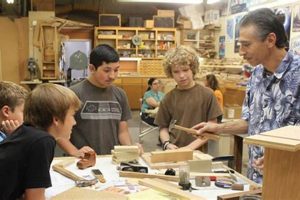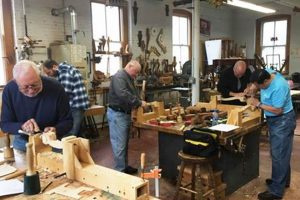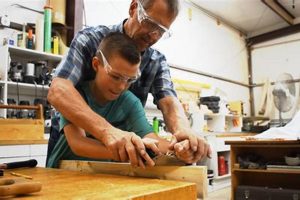Instruction in crafting objects from wood, offered within the geographical boundaries of Maine’s most populous city, provides opportunities for individuals to learn or improve skills in joinery, carving, and furniture making. These instructional programs vary in scope, encompassing beginner-level introductions to woodworking fundamentals as well as advanced courses focusing on specific techniques or project types. For example, a novice might enroll in a class teaching basic tool usage and wood selection, while an experienced woodworker could pursue a course on building period-style furniture.
Participation in such programs cultivates practical skills, fosters creativity, and provides a tangible connection to historical craft traditions. Acquiring proficiency in working with wood allows individuals to create functional and aesthetically pleasing objects, enhancing their living spaces and providing a sense of accomplishment. The historical context reveals a lineage of craftsmanship and resourcefulness deeply embedded within the region’s cultural heritage, connecting contemporary practitioners to a rich tradition of furniture making, shipbuilding, and other wood-based industries.
The availability and diversity of instructional options in the area cater to a wide range of interests and skill levels. Subsequent sections will delve into specific course offerings, explore the instructors and facilities involved, and provide practical information for prospective students seeking to engage in the art of woodworking.
Guidance for Enrolling in Woodworking Instruction
Prospective students seeking to acquire or enhance woodworking skills through formal instruction should consider the following recommendations to maximize their learning experience and ensure a suitable fit with their individual goals.
Tip 1: Assess Skill Level Accurately: Before registering, thoroughly evaluate existing woodworking proficiency. Honest self-assessment allows selection of an appropriate course level, preventing frustration from overly complex projects or boredom from excessively basic instruction.
Tip 2: Define Learning Objectives: Clearly identify desired outcomes from the instruction. Is the goal to acquire fundamental skills for general woodworking, or to master a specific technique such as carving or furniture restoration? Focused objectives streamline course selection.
Tip 3: Research Instructor Credentials: Investigate the instructor’s background, experience, and teaching philosophy. A qualified instructor possesses both practical expertise and the ability to effectively communicate knowledge to students.
Tip 4: Evaluate Workshop Facilities: Consider the adequacy of the workshop space and the availability of necessary tools and equipment. A well-equipped and maintained facility contributes significantly to a positive learning environment.
Tip 5: Review Course Curriculum: Carefully examine the course syllabus to ensure the content aligns with personal learning objectives and interests. Pay attention to the projects undertaken and the techniques covered.
Tip 6: Inquire About Class Size: Smaller class sizes typically allow for more individualized attention from the instructor, facilitating a more personalized and effective learning experience.
Tip 7: Read Student Testimonials: Seek out feedback from previous students regarding their experiences with the instruction. Testimonials can provide valuable insights into the quality of the course and the instructor’s effectiveness.
Acquiring woodworking skills requires diligent practice and informed decision-making. By carefully considering these recommendations, prospective students can optimize their investment in formal instruction and achieve their desired outcomes.
The subsequent section will explore the specific types of woodworking projects commonly undertaken in these instructional settings.
1. Skill Acquisition
The development of woodworking proficiency is central to the function of instructional programs offered in the Portland, Maine area. These programs are structured to impart practical knowledge and abilities across a spectrum of woodworking disciplines, enabling participants to effectively manipulate wood as a medium for creative expression and functional design.
- Fundamental Techniques
These techniques encompass the foundational skills necessary for all woodworking endeavors, including proper tool handling, wood selection, measuring, marking, cutting, joining, and finishing. Instruction typically involves hands-on exercises and demonstrations to instill correct practices and promote a strong understanding of basic principles. For example, a beginner-level class might focus on mastering the use of hand saws, chisels, and planes before advancing to power tools.
- Advanced Joinery
Building upon fundamental skills, advanced joinery involves the creation of complex and durable connections between pieces of wood. Techniques such as dovetailing, mortise and tenon joints, and advanced wood fastening are explored in detail. These techniques are essential for constructing robust furniture, cabinets, and other structural wood components. A class dedicated to joinery might focus on producing various types of dovetails, assessing their strength and aesthetic appeal.
- Specialized Skills
Woodworking skill acquisition extends beyond general techniques to encompass specialized areas like carving, turning, and finishing. Carving involves shaping wood using hand or power tools to create decorative elements or three-dimensional forms. Turning utilizes a lathe to shape wood into cylindrical or conical forms. Finishing entails applying coatings to protect the wood and enhance its appearance. A focused class might teach the art of woodturning, guiding participants through the creation of bowls, spindles, and other turned objects.
- Project-Based Learning
The culmination of skill acquisition is often realized through project-based learning. Students apply their acquired knowledge and abilities to complete specific woodworking projects, such as building a small table, a cabinet door, or a decorative box. Project-based learning provides practical experience, fosters problem-solving skills, and allows students to create tangible objects that demonstrate their proficiency. A final project in a comprehensive woodworking course might involve designing and constructing a small piece of furniture, incorporating various learned techniques.
Through structured instruction and hands-on practice, the available learning opportunities in the specified locale foster a comprehensive understanding of woodworking principles and techniques, enabling individuals to develop proficiency and confidence in working with wood. The emphasis on both fundamental skills and specialized techniques ensures that students are well-prepared to pursue a wide range of woodworking projects and creative endeavors.
2. Craft Traditions
Woodworking instruction within Portland, Maine, is inextricably linked to enduring craft traditions, a connection that provides both context and substance to the learning experience. The historical presence of shipbuilding, furniture making, and other wood-based industries in the region has shaped a cultural landscape where woodworking skills are valued and preserved. Consequently, instruction often incorporates elements of these historical practices, teaching students techniques and designs that reflect the area’s rich woodworking heritage. This infusion of tradition not only imparts practical skills but also instills an appreciation for the historical significance of the craft.
The influence of craft traditions manifests in several ways. Some instructional programs focus specifically on replicating historical furniture styles, such as Shaker or Federal designs, requiring students to master the hand tools and joinery methods used by artisans of those periods. Other programs incorporate traditional decorative techniques, such as carving or inlay, allowing students to create objects with a distinct historical aesthetic. Moreover, the emphasis on sustainable practices in many woodworking classes reflects a growing awareness of the environmental impact of resource extraction, mirroring the resourcefulness of early Maine woodworkers who relied on locally sourced materials and efficient techniques.
The integration of craft traditions into woodworking instruction serves to connect contemporary practitioners with the legacy of their predecessors. By learning and applying time-honored techniques, students gain a deeper understanding of the challenges and innovations that have shaped the craft. This connection fosters a sense of continuity and purpose, encouraging students to not only master the skills of woodworking but also to contribute to the ongoing evolution of the craft while respecting its historical roots. The challenge lies in balancing the preservation of tradition with the embrace of modern techniques and designs, ensuring that the craft remains relevant and vibrant in the 21st century.
3. Project-Based Learning
Project-based learning serves as a cornerstone in woodworking instruction offered within the Portland, Maine area. This pedagogical approach emphasizes active learning and the practical application of woodworking skills through the completion of tangible projects. Its relevance stems from the inherently hands-on nature of woodworking, where theoretical knowledge gains significance through physical creation.
- Skill Integration
Project-based learning provides a framework for integrating various woodworking skills acquired during instruction. Rather than learning skills in isolation, students apply them in a cohesive manner to complete a specific project, such as building a table or crafting a box. This integration fosters a deeper understanding of how different techniques interrelate and contribute to the overall outcome. An example includes a student utilizing joinery techniques, wood finishing methods, and design principles in a single project.
- Problem-Solving
Woodworking projects inevitably present challenges, requiring students to develop problem-solving skills to overcome obstacles. From adapting designs to working with imperfect materials to troubleshooting tool malfunctions, students learn to analyze problems, devise solutions, and adapt their approach as needed. For instance, a student might encounter warping in a piece of wood and need to adjust their construction method to compensate.
- Real-World Application
Project-based learning simulates real-world woodworking scenarios, providing students with practical experience that extends beyond theoretical knowledge. By working on projects that mimic the types of tasks they might encounter in a professional or personal setting, students gain confidence and develop the ability to apply their skills in diverse contexts. This might involve constructing a piece of furniture for a client or designing and building a custom storage solution for their home.
- Tangible Outcomes
The completion of a woodworking project results in a tangible outcome a physical object that students can be proud of and use in their daily lives. This tangible result provides a sense of accomplishment and reinforces the value of the skills they have acquired. The creation of a functional and aesthetically pleasing object, such as a handcrafted chair or a finely finished cutting board, serves as a lasting testament to their woodworking abilities.
These facets collectively illustrate how project-based learning enriches the educational experience in woodworking classes. The tangible results, problem-solving opportunities, skill integration, and real-world application prepare individuals to confidently engage in diverse woodworking activities within the community and beyond.
4. Tool Proficiency
The attainment of competence in using woodworking tools is a critical component of instruction offered in Portland, Maine. These instructional programs prioritize not only the theoretical understanding of woodworking principles, but also the practical application of these principles through the skillful manipulation of hand and power tools.
- Safe Operation Protocols
Instruction emphasizes adherence to stringent safety protocols for all tools used in the woodworking process. Demonstrations cover correct usage, maintenance, and personal protective equipment requirements. This includes detailed explanations of safety features on power tools, such as blade guards and emergency stops, as well as guidelines for the safe handling of hand tools, such as chisels and saws. Improper tool handling poses significant risks in a woodworking environment; therefore, safety is paramount.
- Hand Tool Mastery
Proficiency in using hand tools, such as saws, planes, chisels, and hand drills, is cultivated through hands-on practice and guided instruction. Emphasis is placed on developing the fine motor skills and precision required for accurate and efficient woodworking. Students learn to sharpen and maintain their hand tools, ensuring optimal performance and longevity. The mastery of hand tools provides a foundational understanding of woodworking principles and fosters a tactile connection to the materials.
- Power Tool Application
Instruction incorporates the safe and effective use of power tools, including table saws, jointers, planers, routers, and sanders. Students learn to select the appropriate tool for each task, adjust settings accurately, and operate the equipment in a controlled manner. Power tool instruction emphasizes understanding the capabilities and limitations of each tool, as well as the potential hazards associated with their use. Proper power tool application is crucial for efficient and accurate woodworking.
- Maintenance and Repair
A component of tool proficiency involves basic maintenance and repair procedures. Students learn to clean, lubricate, and adjust their tools to ensure optimal performance and extend their lifespan. Simple repairs, such as replacing worn parts or sharpening blades, are also covered. Understanding tool maintenance promotes responsible tool ownership and reduces the reliance on external repair services. Proper maintenance is essential for maintaining tool accuracy and safety.
These facets, integrated into the woodworking curriculum, aim to cultivate a holistic understanding of tool proficiency. This understanding equips individuals with the skills and knowledge necessary for safe, efficient, and accurate woodworking, promoting responsible craftsmanship within the Portland, Maine woodworking community and beyond.
5. Creative Development
Woodworking instruction in Portland, Maine, serves not only to impart technical skills but also to cultivate creative development. The connection between the two is symbiotic: mastery of woodworking techniques provides the foundation for creative expression, while creative thinking informs the application and evolution of those techniques. A student might learn the fundamentals of mortise and tenon joinery, but their creative development is fostered when they are encouraged to adapt that joint to a unique design, incorporating it into a piece of furniture that reflects their personal aesthetic. Creative development in woodworking classes enhances a student’s ability to design original projects, solve design challenges, and personalize their creations. This process necessitates experimentation, the willingness to deviate from established norms, and the ability to visualize the final product before its realization.
The instructional environment within Portland, Maine often includes project-based assignments specifically designed to encourage creative exploration. Students are given a set of constraints, such as the type of wood to be used or the intended function of the piece, and then challenged to develop their own designs within those parameters. One might find assignments where students repurpose reclaimed materials into a functional item, or a project focused on creating pieces that blend traditional techniques with modern design principles. Instructors act as facilitators, providing guidance on technique and structural integrity, but also encouraging students to explore their creative potential and develop their own unique style. Furthermore, students may be exposed to the work of contemporary woodworkers and designers to expand their understanding of creative possibilities within the field. Exposure to diverse styles and approaches broadens their perspective and encourages them to push the boundaries of their own creativity.
In summary, creative development is a central element of the woodworking experience in Portland, Maine, enabling students to move beyond rote execution and embrace innovation. This process prepares students to contribute meaningfully to the craft, ensuring its continued evolution. The challenge lies in balancing technical skill with artistic vision, encouraging students to master the fundamentals while simultaneously fostering their individual creative expression. This approach ensures the lasting relevance and dynamism of woodworking as both a craft and an art form.
6. Community Engagement
Community engagement forms a vital component of woodworking instruction within Portland, Maine. The presence of communal workshops, collaborative projects, and outreach programs highlights the interconnectedness of the craft and the local populace. Engagement fosters a supportive learning environment, promotes skill sharing, and cultivates a sense of collective responsibility toward preserving woodworking traditions. Enrollment in instructional programs extends beyond individual skill acquisition, as participants become integrated into a network of artisans, hobbyists, and educators who share a passion for the craft. This integration contributes to the social fabric of the city, fostering a sense of belonging and shared purpose. For example, local woodworking guilds frequently partner with instructional centers to host workshops, exhibitions, and community service projects, thereby bridging the gap between formal education and real-world application.
The practical significance of this engagement is multifaceted. It facilitates mentorship opportunities, where experienced woodworkers can guide and inspire newcomers to the craft. It provides avenues for collaborative projects, such as building furniture for local charities or restoring historic structures, which strengthen community bonds and provide valuable hands-on experience. Moreover, community engagement can promote economic development by supporting local businesses and attracting tourism. Craft fairs and exhibitions showcase the work of local woodworkers, generating revenue and raising awareness of the region’s rich woodworking heritage. The Maine Woodworkers Association, for instance, organizes events that connect local craftspeople with potential customers and collaborators, fostering a thriving woodworking economy.
In conclusion, community engagement serves as an integral element of woodworking instruction in Portland, Maine, fostering a supportive learning environment, promoting skill sharing, and cultivating a sense of collective responsibility. It contributes to the social and economic vitality of the region, bridging the gap between formal education and real-world application. Recognizing and supporting this connection is crucial for ensuring the continued growth and sustainability of the woodworking community in Portland and beyond. A persistent challenge involves maintaining accessibility and inclusivity, ensuring that woodworking instruction and community engagement opportunities are available to individuals from diverse backgrounds and skill levels.
Frequently Asked Questions
The following addresses common inquiries regarding woodworking instructional programs available within the Portland, Maine area. Information is presented to clarify program specifics and address potential concerns.
Question 1: What types of woodworking classes are typically offered in the Portland, Maine area?
Instructional offerings generally span beginner-level introductions to woodworking, intermediate courses focusing on specific techniques such as joinery or carving, and advanced workshops exploring furniture making and project design. Some programs may also offer specialized classes on topics such as woodturning or antique restoration.
Question 2: Are woodworking classes in Portland, Maine suitable for individuals with no prior experience?
Many programs cater to individuals with no prior woodworking experience. These beginner-level courses focus on fundamental skills, including tool safety, wood selection, and basic joinery techniques. Progression to more advanced classes is typically permitted upon demonstration of proficiency in foundational skills.
Question 3: What is the typical duration and cost of a woodworking class in Portland, Maine?
Class duration and cost vary significantly depending on the program, the instructor, and the complexity of the material covered. Introductory classes might range from a single-day workshop to a multi-week course, while advanced programs may extend over several months. Tuition fees can range from a few hundred dollars for a basic class to several thousand for a comprehensive program.
Question 4: Are tools and materials provided in woodworking classes, or are participants expected to supply their own?
The provision of tools and materials varies between programs. Some courses include all necessary tools and materials in the tuition fee, while others require participants to bring their own hand tools or purchase materials separately. Prospective students should inquire about specific requirements before enrolling.
Question 5: What safety precautions are emphasized in woodworking classes in Portland, Maine?
All reputable woodworking programs prioritize safety. Instruction includes comprehensive training on the safe operation of hand and power tools, as well as the proper use of personal protective equipment. Adherence to safety protocols is strictly enforced to minimize the risk of accidents.
Question 6: Are there opportunities for advanced students to pursue independent projects or apprenticeships after completing woodworking classes in Portland, Maine?
Some programs offer opportunities for advanced students to pursue independent projects under the supervision of an instructor. Additionally, local woodworking businesses and craftspeople may offer apprenticeships or mentorships to promising graduates. Networking within the local woodworking community can also facilitate opportunities for advanced skill development.
These responses aim to provide clarity regarding the scope and nature of woodworking instruction available within the defined region. Careful consideration of individual needs and program offerings is essential for a successful learning experience.
The following will address resources that can further expand information regarding woodworking instructional offerings.
Conclusion
This exploration of woodworking classes portland maine has revealed the multifaceted nature of such instruction, encompassing skill acquisition, historical context, project-based learning, tool proficiency, creative development, and community engagement. The availability of these programs within the specified geographic area provides individuals with opportunities to learn or enhance their woodworking abilities, fostering both practical skills and artistic expression. It’s clear that prospective students have diverse needs and ambitions, necessitating a comprehensive understanding of the programs’ nature, scope, and emphasis.
Given the continuing value placed on both functional design and traditional crafts, the role of accessible and comprehensive woodworking instruction will only increase. Further investigation into specific program offerings and instructor qualifications is encouraged to ensure the best possible educational experience. The dedication to preserving and promoting the art of woodworking will serve to enrich both individual lives and the broader community within Portland, Maine.







